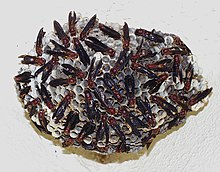Polistes annularis
| Polistes annularis | |
|---|---|
 |
|
| Polistes annularis at a mature nest | |
| Scientific classification | |
| Kingdom: | Animalia |
| Phylum: | Arthropoda |
| Class: | Insecta |
| Order: | Hymenoptera |
| Family: | Vespidae |
| Subfamily: | Polistinae |
| Tribe: | Polistini |
| Genus: | Polistes |
| Species: | P. annularis |
| Binomial name | |
|
Polistes annularis (Linnaeus, 1763) |
|
| Synonyms | |
|
|
Polistes annularis (P. annularis) is a species of paper wasp which lives in North America. Its species name is Latin for "ringed" and it is known for its distinct red body color. It builds its nest under overhangs near bodies of water that minimize the amount of sunlight penetration. It clusters its nests together in large aggregations, and consumes nectar and other insects. Its principal predator is the ant, although birds are also known to prey on it. It is a primitively eusocial wasp, meaning that all individuals develop the capacity for reproduction, regardless of social caste. This primitive eusociality has been seen in bees as well, including the sweat bee, Lasioglossum zephyrum. As such, P. annularis demonstrates behavior typical of other polistine wasps, and has a dominance hierarchy, relatively small colony size, and a female-biased sex ratio. Unlike other wasps, P. annularis is relatively robust in winter conditions, and has also been observed to store honey in advance of hibernation. It is closely related to P. major, P. buysonni, and others in the subgenus Aphanilopterus, and slightly less related to the more common P. bellicosus, P. carolina, P. metricus, and P. fuscatus.
While many other North American Polistes species show sexual dimorphism in coloration, P. annularis and P. erythrocephalus do not. This species differs from P. metricus in terms of the coloration of the antennae and thorax. There is geographical variation in coloration between northern and southern populations. In the north, the thorax of P. annularis has ferruginous (rust-red) markings on a predominantly black background, while in the south, the thorax is mostly ferruginous, with black markings. The legs also vary from black to ferruginous. In terms of size, the fore wings are 18.5–23.5 mm (0.73–0.93 in) long in females, and 17.5–19.5 mm (0.69–0.77 in) long in males. Both males and females are red-faced, which makes intersex determination less straightforward; however, it also makes it easier to recognize members of this species compared to other closely related species. Its initial metasomal segment is narrow, a feature that it has in common with P. bahamensis.
...
Wikipedia
